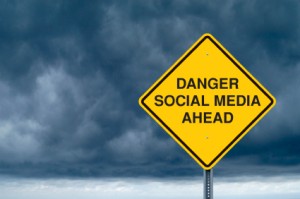Social Media, Bosom Buddies, and Christmas Card Friends

Bosom Buddies
I try to keep up with the latest trends in social media. I’m especially interested in how my clients might use it to improve communications internally with employees or externally with customers and partners.
Over the years, I’ve seen the persistent criticism that the “social” in social media is Orwellian – it does the opposite of what it claims to do. Just as Big Brother promised freedom but offered enslavement, social media promise to create closely knit communities but actually insert an intermediate layer where none is needed. Rather than making us more social, it separates us further.
That’s the complaint… but is it true? As I use social media, I find that I need to segment the market to get real benefits. For some segments, social media doesn’t help me much at all. For other segments, it keeps me in better contact with people than ever before.
The two big segments for me are: 1) Bosom Buddies, and; 2) Christmas Card Friends. Bosom Buddies have two defining characteristics: 1) they’re close friends or colleagues that I want to keep up with, and; 2) I see them or talk to them or e-mail them often. I know what’s going on in their lives.
With Bosom Buddies, social media add no value whatsoever. I’ve never, ever learned a juicy new tidbit about a Bosom Buddy from a social media source. I’ve always heard it first from a more traditional source – a dinner party, a phone call, or just plain old-fashioned gossip. Social media add an unnecessary layer of communication that doesn’t get me any closer to my Bosom Buddies.
With Bosom Buddies, the grapevine is a powerful and prolific source of information. In fact, I sometimes hear that active participation in social media is an effective substitute for going to the office. With Bosom Buddies, the reverse is true: going to the office is an effective substitute for social media.
With Christmas Card Friends, things are different. I like my Christmas Card Friends just as much as my Bosom Buddies but I don’t see them nearly as often. They may live in another town. Or maybe they travel in slightly different social circles. Or maybe they have young children and don’t get around much any more.
Whatever the case, I don’t get to see them as often as I’d like. Nor do I hear from them (or they from me) frequently, even though I would like to. In some cases, I only hear from them though the traditional social medium called Christmas Cards.
With Christmas Card Friends, social media can add significant value. I can fairly easily keep up with people I enjoy but don’t interact with regularly. Social media are a source of new news. I regularly learn new things about Christmas Card Friends through social media. I enjoy that and I think it enriches our relationship.
As you think about social media – whether personal or professional – think about your market segments. You may find that targeting Christmas Card Friends rather than Bosom Buddies will lead you to richer, more enjoyable interactions.
Teens Dump Social While Companies Rush In
 Last month a Piper Jaffray survey asked 5,000 teenagers in the United States to identify their “most important social media sites.” Facebook was still the most important but it had declined steeply compared to Piper Jaffray surveys taken six months and 12 months earlier. Indeed, Facebook was barely ahead of YouTube.
Last month a Piper Jaffray survey asked 5,000 teenagers in the United States to identify their “most important social media sites.” Facebook was still the most important but it had declined steeply compared to Piper Jaffray surveys taken six months and 12 months earlier. Indeed, Facebook was barely ahead of YouTube.
Why did it happen? Well, teenagers are fickle. Additionally more and more old folks are invading the Facebook space, which may be driving the younger set away. Advertising may be partially to blame as well. As I learned with my brief foray into Facebook advertising, a lot of users react violently to the presence of ads in their news feeds.
Overall, however, I think the most cogent analysis comes from Cliff Watson’s blog on Medium. Watson essentially says that teens have better things to do and faster, simpler ways of doing it.
As the teens decamp, however, companies are rushing into social media. In March, McKinsey published its sixth annual survey on the business use of social media. The survey, conducted in 2012, received responses from 3,542 executives representing companies around the world. Some 83 percent of respondents say their companies are using at least one social medium (up from 72 percent in 2011) and 90 percent of those report measureable benefits.
Companies are using social media both internally and externally. The top benefits for internal use (in order) are: 1) faster access to knowledge; 2) reduced communication costs; 3) reduced travel costs. For external use, the top three benefits are: 1) increased marketing effectiveness; 2) increased customer satisfaction; 3) reduced marketing costs.
This also seemed to be the year that companies jumped on the mobile bandwagon. Sixty-five percent of the respondents said their companies were using at least one social medium on mobile technologies. As in previous surveys, the three primary uses for mobile were: 1) marketing; 2) sales; 3) IT.
While mobile is growing rapidly, the use of big data is more of a challenge. Indeed, executives don’t quite seem to know what to make of big data. According to McKinsey, “ … between 42 and 54 percent of respondents say either that they don’t know how their companies use the data or that these practices aren’t yet applicable to their companies.”
And the downside? A majority of respondents say that the major risk is that confidential information may be leaked. But 60 percent agree that the benefits outweigh the risks.
Teens seem to be moving away from “traditional” social technologies while companies are moving in. Coincidence? I think not. It’s like two animals competing for the same ecological niche. As one moves in, the other moves out. That’s not necessarily a bad thing. Companies can still get a lot of benefits from social media. They just won’t get the teens.